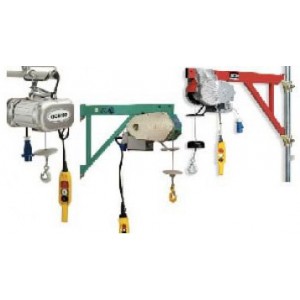
Construction projects often require building intricate scaffolding structures to safely work at height. However, transporting heavy loads of construction materials up to workers on scaffolds can be challenging. The manual process of carrying tools, equipment and building supplies up and down ladders is time-consuming, exhausting and raises safety risks.
A more efficient solution exists - the scaffold hoist. In this blog, we explore what exactly scaffold hoists are, why they benefit worksites, the different varieties available and crucial safety considerations for proper operation.
In essence, a scaffold hoist is a powered hoisting system mounted on a scaffold that can raise and lower suspended loads to working heights. Hoists feature an integrated electrical, hydraulic or pneumatic lift mechanism that pulls wire rope to lift payloads weighing from 500kg up to 1000kg or more.
Operators control scaffold hoists remotely via a control pendant or integrated control panel. This allows them to precisely direct lifts and avoid standing directly below or near loads. Most hoists have variable speed options and safety features like braking systems, overload protection and emergency stop buttons.
There are numerous benefits to using specially-designed hoists rather than traditional manual labour:
Increased efficiency - Hoists overcome the time constraints and energy drain of workers carrying supplies by hand. Loads are lifted swiftly and directly to the point of use. This also prevents productivity loss from worker fatigue or minor lifting strains.
Enhanced safety - Taking staff members out of material transport significantly reduces injury risks. Sudden load drops, slips, trips and falls leading to back strains or fractures are mitigated. Site managers also gain assurance that scaffolds will not be overloaded.
Versatility - Scaffold hoists can lift anything ranging from bricks, scaffold boards and concrete to tools and debris for clean-up after works completion. More finished work is achievable per day.
Lower costs - Yes, safety-approved hoists represent a larger capital investment to purchase or hire than manual alternatives. Yet reduced labour expenditure and workplace incident payouts deliver return on investment in the long run.
Electric and pneumatic (air-powered) hoist models are the two main varieties used in scaffold lifting:
Electric Hoists - Offer greater lifting capabilities for heavier loads but require connection to on-site electrical supply.
Pneumatic Hoists - Use compressed air power for advantage of being self-contained and movable. Lift capacity is generally less however.
Within each hoist type, different duty ratings cater to light, medium or heavy lifting loads. Larger containerised hoists also exist for transferring especially heavy materials requiring fixed base stability.
Regardless of model, inspecting intended scaffold installations and access points with an experienced supplier enables appropriate selection. All equipment must satisfy Lifting Operations and Lifting Equipment Regulations standards and undergo thorough examinations.
Whilst lifting productivity significantly, scaffold hoists themselves require responsible operation. Operators need proper training and hoists warrant pre-use checks ensuring correct functionality. Exclusion zones should restrict access underneath loads in transit as even small falling objects can inflict injuries.
By instilling adequate safety measures and understanding crucial technical factors like load charts and safe working loads, scaffold hoists promote rather than compromise worker welfare. They facilitate construction and maintenance programs safely, reliably and cost-effectively across long time frames.
In summary, scaffold hoists are an indispensable asset on modern construction sites. Their ability to transfer heavy materials quickly whilst protecting operators from handling risks proves invaluable for efficient works completion. This allows projects to continue upward and outward without difficult, unsafe manual labour hampering progress.